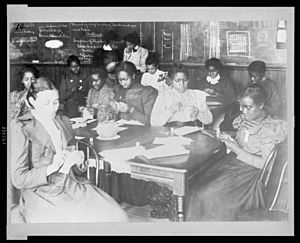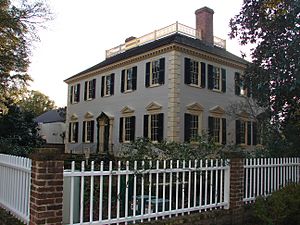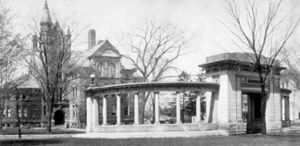Sara G. Stanley facts for kids
Sara Griffith Stanley Woodward (1837 – 1918) was an amazing African-American woman who fought for freedom and fairness. She was an abolitionist (someone who wanted to end slavery), a teacher, and a writer. Even though her family, both Black and White members, had owned slaves, Sara spent most of her life working to help African Americans gain their freedom and equal rights. She was lucky to get a good education at Oberlin College, which was one of the first colleges in the United States to welcome African American students. Sara wrote many articles against slavery, but her most famous work was a speech she wrote for the Delaware Ladies' Antislavery Society in 1856. After the Civil War, she taught African-American children in both the North and the South, helping them learn and grow.
Contents
Growing Up and Learning
Sara Stanley was born in 1837 in New Bern, N.C.. Her family were "free blacks," meaning they were not enslaved. She was one of six children. Her father, John Stewart Stanley, came from a respected and well-known family. This helped the Stanleys open a school for Black children in New Bern. Sara's parents were teachers at this school, so she grew up loving to learn.
As a child, Sara went to the First Presbyterian Church. It was common for Black and White people to worship together there, because at that time, Black people in North Carolina were not allowed to have their own churches.
When Sara was sixteen, her mother sent her to Oberlin College in Ohio. She studied there for three years and earned a diploma that allowed her to teach. Oberlin was special because it offered an education to students of different races, which was rare before the Civil War. This experience helped Sara become a strong supporter of education and equal rights.
After a slave uprising in South Carolina in 1822, new laws made it harder for free Black people in North Carolina. These laws forced Sara's father to close his school. So, her family moved to Ohio in the mid-1850s. After finishing her studies, Sara moved with her parents to Cleveland, Ohio. Her parents opened another school for Black children, and Sara taught there before moving to public schools.
Fighting for Freedom
By the time she was 18, Sara became an active abolitionist. She had grown up seeing enslaved people on her family's farm and had family members who were enslaved. She became an important leader and represented the Delaware Ladies Anti-slavery Society. For them, she wrote a powerful speech to be read at the State Convention of Colored Men in 1856. This meeting was for men only, who were discussing the right for Black men to vote. Since women were not allowed inside, her speech was read aloud by a man named William Harris.
In her speech, Sara asked the men to use their Christian faith to help end slavery and fight for their rights. She said that as "Christian wives, mothers, and daughters," they promised to work constantly for "Liberty and Humanity." This speech helped her become a known writer against slavery. She also wrote articles for newspapers like the Weekly Afro-American and American Missionary.
In 1867, she wrote about an interview she had with an elderly formerly enslaved woman. Sara was deeply moved by the woman's sad story. She wrote about how much we can learn from these brave people and asked for prayers to stay strong in her work.
Teaching Freed People
In March 1864, even before the Civil War ended, Sara joined the American Missionary Association (AMA). This group worked to end slavery, educate African Americans, promote equality, and spread Christian values. By May, Sara was sent to Norfolk, Virginia for her first teaching job at the Bute Street School. She taught African-American students who had recently been freed from slavery.
Teaching during the war was very difficult. There were soldiers everywhere, and many teachers left because of the tough conditions and illnesses.
There were also problems between the Black and White teachers. In one case, Sara and another Black teacher, Edmonia Highgate, wrote a letter complaining about a White professor named William Croan. They said he was unfair to the Black students he was teaching.
Another issue happened with a White teacher, Mrs. Gleason, who did not want to work with African-American staff. She wrote letters asking for all African-American teachers to be removed. Sara was especially upset by this. Because she had light skin and even blue eyes, she could sometimes be mistaken for White. Before Mrs. Gleason's comments, Sara had not highlighted her race. In a letter, Sara wrote about how sad it was to see such prejudice from missionary teachers.
Because Sara was outspoken and light-skinned, some people, both White and Black, thought she was "haughty" (proud or arrogant).
Even though Sara was allowed to stay with the AMA, she was sent to St. Louis, Missouri two months later. Her new school was a "small, windowless room in a church basement." It had very little money or supplies. But Sara was impressed by her students. She noticed that many of the children had lighter skin, blond or red hair, and light complexions. She wrote that this showed the terrible wrongs of slavery.
In just two months, Sara improved the school by buying supplies with her own money and starting a successful Sunday school. The AMA was slow to pay her, but Sara refused to charge tuition to students who couldn't afford it. In the fall of 1865, after the Civil War ended, the school board changed from all-Black to all-White. The new White board wanted to replace Black teachers with White ones. They forced Sara to leave, and she ended up in debt.
Her next job was in Louisville, Kentucky, where she taught in the basement of a church. Despite the difficult conditions, she helped more students attend, and by May 1866, she became the principal. But when the government's Freedman's Bureau took over the public schools, Sara again found herself without a school.
By 1868, she moved to Mobile, Alabama, still teaching for the AMA. Sara stayed with the AMA until she left Mobile in 1870.
Family Life
While teaching in Alabama in 1868, Sara met Charles A. Woodward. He was a White man who had served in the Union army during the war. Charles worked at the Freedmen's Bank. He was four years younger than Sara. Even though Sara was fair-skinned and both had blue eyes, he was White, and she was known as a proud Black woman. There was some concern about their marriage, especially because the AMA feared problems with the local Ku Klux Klan. The wedding happened "quietly" at a friend's house.
After their marriage, the Woodwards lived and worked in Mobile for several years. Sara continued to teach for the AMA and also worked part-time with her husband at the Freedman's Bank.
At some point, Sara gave birth to a baby girl, but sadly, the baby died at six months old.
In 1874, Charles was accused of taking money from the bank, but he was found not guilty after a short trial. Soon after, the Woodwards moved to New Jersey. Charles died in 1885.
Later Life and Legacy

After her husband passed away, Sara moved to Philadelphia. She received a small military pension and worked as an engraver to earn more money.
In 1894, she briefly taught with another famous abolitionist and educator, Lucy Craft Laney, at a school for Black women in Augusta, Georgia. This school was later renamed "The Lucy Craft Laney Comprehensive High School."
Not much is known about Sara's very late life. In 1910, she was living in New Jersey. Sara Griffith Stanley Woodward died in 1918 at the age of 82. Her final resting place is not known, but her legacy as a fighter for freedom and education lives on.
|



